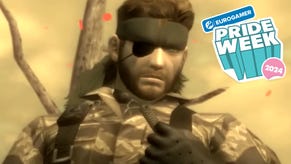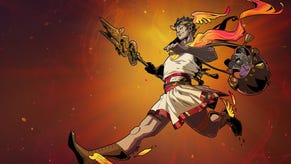How the Overwatch 2 battle pass works, and everything you need to know about it
Mei I?
Blizzard has explained in detail how the Overwatch 2 battle pass and associated monetisation will work. The information comes from a briefing document and roundtable group interview I attended last night.
There are no loot boxes in Overwatch 2, in case you didn't know. In their place are a battle pass and in-game store, where you'll directly buy what you want, using a new currency called Overwatch Coins.
The Overwatch 2 battle pass has two tiers, free and paid, and you will be able to unlock all new Overwatch 2 heroes on that free track. New heroes will be unlockable at tier 55, of around 80 total tiers.
Alternatively, you can unlock a new hero instantly by purchasing the premium battle pass, which costs 1000 Overwatch Coins, around $10.
The new hero in Season One is Kiriko, the support character who leaked recently. But if you're migrating from Overwatch 1 to OW2, you get all launch characters for free anyway - Sojourn, Junker Queen, and Kiriko. It's only completely new players who need to unlock them.
Here are the two battle pass offerings side by side for Season One.
Season One free tier:
- Kiriko (at tier 55)
- 2 Legendary Skins
- 2 Weapon Charms
- 2 Souvenirs
- 1 Highlight Intro
- 15 additional items (list types, emotes, etc)
Season One premium tier:
- Immediate access to Kiriko
- 15% XP Battle Pass Boost
- 1 Mythic Skin
- 5 Legendary Skins
- 2 Epic Skins
- 3 Play of the Game Intros
- 4 Weapon Charms
- 3 Emotes
- 3 Souvenirs
- 6 Poses
- 6 Name Cards
- 8 Player Icons
- 11 Voice Lines
- 12 Sprays
You can upgrade mid-season and gain all the previous rewards you missed.
The mythic skin you see in the premium list represents a new tier of skin above legendary, the current highest. Mythic skins are customisable, featuring layers you can mix and match with different colours and patterns. The plan is for there to be one mythic skin every season, the first being a Cyber Demon skin for Genji.
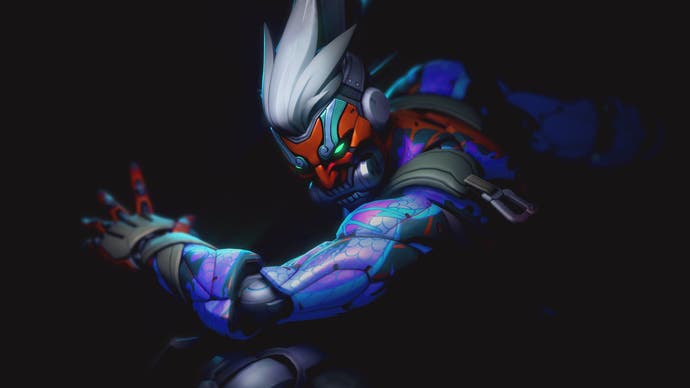
Mythic skins apparently take about a year to make, so they're a big deal, and I know people were worried - because of a leaked Overwatch 2 survey a while back - they could cost as much as $45 from the in-game shop. But as it stands, there are no plans to sell them there at all.
"We don't have any plans to do that in the near future," Jon Spector, commercial lead, told me during the roundtable. "That's not to say that we wouldn't, somewhere down the line.
"One of the things about mythic skins is that it takes us more than a year to build ... that whole pipeline, start to finish, is more than a year. So we are working on mythic skins already that you won't see until the end of 2023 and beyond.
On selling mythic skins: "We don't have any plans to do that in the near future. That's not to say that we wouldn't, somewhere down the line." -Jon Spector, commercial lead
"So when we look at, well, we're releasing one mythic skin in each of the first few seasons and we have thirty-five amazing heroes, you could get to a place where down the line, we'd want to create ways for a new player who's missed out on mythic Genji, because they didn't play in season one, where it could make sense to offer them a path to get that skin. But we don't have any specific plans to do that in the near future."
To clarify, then, Genji's mythic skin is only obtainable through the battle pass for the foreseeable future.
You can also see a couple of other new kinds of cosmetics in the lists above: charms and souvenirs. These weren't discussed in detail but are presumably relatively insignificant. There are also name cards, which sound like titles to unlock. There are special name cards offered for going about the battle pass tier-cap of 80 and into prestige tiers.
New heroes will not enter Competitive Play immediately. This is for two reasons: one, to monitor and tune them; and two, to give people time to unlock them via the battle pass.
If you miss a season and hero with it, there will be a chance to retroactively unlock them via challenges or, apparently, buy them directly from the in-game shop. I do not know how much they'll cost.
Battle pass seasons run for nine weeks and there will be a new hero in every other one, in an alternating pattern with new maps. However, Seasons One and Two will both have new heroes in; after that it will be Season Four, Six, etc. Season One will also have a new map in, called Esperança, which is set in Portugal and is gorgeous.
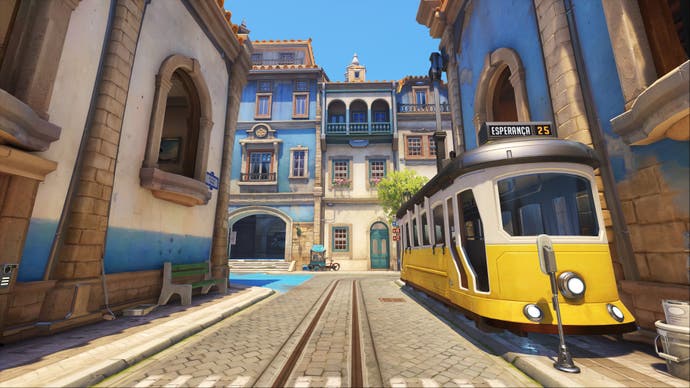
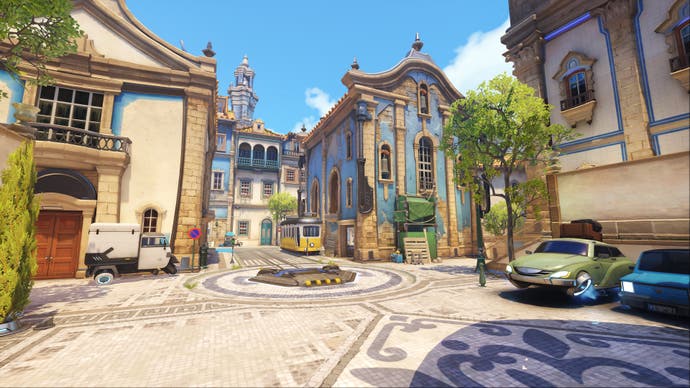
Additionally, Season One will see the return of the popular event, Wrath of the Bride of Junkenstein. The plan is to bring back other time-limited events from Overwatch's history too. And there are new ones coming. Blizzard said during the roundtable interview the game will debut "a cool new co-op experience" for Halloween this year - a Junkenstein event.
That's it, broadly. Here are some chopped excerpts from the Q&A. I've picked out a couple of highlights in bold.
How long is it going to take to unlock a new hero, in play terms?
Jon Spector, commercial lead: "So the first really important thing to note here is the way that we've built all of these systems, you're really talking about I have thirty-five heroes already, what happens when hero thirty-six comes out? A lot of free-to-play games, and games that ask players to unlock their characters in them, you start out with five of the twenty [characters], something like that.
"A question about 'how long does it take to get all the heroes?' [...] When we think about the the tuning there, the reason why we put her at at tier 55 on the free track, instead of tier 80, was that we really do want our players to unlock these heroes - we're not trying to put them far out of reach or or make it really hard for typical players to get there.
"What that actually looks like, and we've used some of the existing data that we have on Overwatch 1 players to do this tuning, is that if you are a more hardcore player and you're playing a lot of Overwatch 2, with the goal of unlocking Kiriko as fast as you possibly can, you'll get there within the first few weeks before we move her into Competitive ranked play.
"On the more... We don't have a typical player, there's no average Overwatch player [...] But the more average player, we expect to unlock new heroes a little bit later on in the season, but to be able to get there well before our season ends.
"Then in future seasons, for someone who joins Overwatch 2 later, or didn't play to progress their battle pass in the season when the hero came out, we'll also offer free challenges for those players to go in and unlock heroes in future seasons if they'd like."
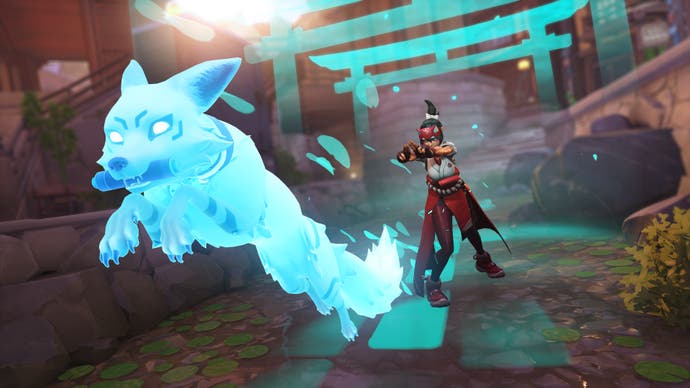
Why new seasons every 9 weeks?
Aaron Keller, game director: "There's probably a few ways to answer a question like this. One lens that you could look at it through is that of the player. We want to create the most exciting version of Overwatch 2 that we can for players, and part of that is to constantly be releasing new content for the game. If there's anything we've heard from players over the last few years, it's that they want us to be making more content for Overwatch, and so we've heard them loud and clear, and the seasons are the device that that we use to deliver most of that content to our players.
"In one aspect, we think that roughly every nine weeks, or roughly every two months, is about the right amount of time to be implementing big new pieces of content into the game. If you start going much longer than that, we feel like players - especially players that are dedicated to the game and play it a lot - they might start feeling like the game hasn't updated as much as they would like it to. And if you go much shorter, actually sometimes it can be a little bit disruptive.
"We are intentionally making a hero every other season. Every time we introduce a hero to the game, it has a really big splash. It's one of the most exciting things, if not the most exciting thing that we can put into the game. And if we were to do it constantly, it actually starts to get a little bit disruptive to the meta, disruptive to our players, and it's hard to keep up with something like that.
"For instance, we've been playtesting our Season Eight hero for months now. We're working on maps that I think are releasing in Season Thirteen." -Aaron Keller, game director
"The reason that we're creating seasons and creating this battle pass: we want to fund development on this project. Like I said, players want more content for Overwatch. The great thing is, the team wants to be making more content for Overwatch - it's what we're all so passionate about, this game and game development in general. We love building things for this universe. And so we have done our best to construct a model where we can build all of the cool things that players are asking us for, all of the cool things that we want, and be able to fund that over the long haul.
"The very last thing I'll say about this is that some of the things the Overwatch team makes can be considered best quality in the world, or top of the industry. We spend so much time building our assets. The mythic skin takes us over a year to make, our heroes take us over a year to make, maps take us over a year to make. We pour so much love, dedication, passion and energy into all of these things. And the great thing about it is, players get to experience that, they get the reward from it.
"It forces us to really be on top of the game as far as what we're planning to release, and how far ahead of our releases we're working. For instance, we've been playtesting our Season Eight hero for months now. We're working on maps that I think are releasing in Season Thirteen. We have a lot of ambitions and a lot of strategies around this. But releasing continuously and keeping up that cadence is what allows us to fund all of this development at this incredibly high bar that we're always shooting for, with this very frequent amount of content that we're dedicated to doing over the long term."
What kind of new heroes are they working on?
Aaron Keller, game director: "We love adding new heroes to the game, and we love the ability to add different types of gameplay when we do it. Now, when I talk about gameplay, it can mean several different things, so we look at introducing new heroes in several different ways.
"The first is just mechanics that we can add to the game that we don't necessarily have right now, and it's always great to be able to add something like that. With some of the new heroes that we're developing, and one in particular that I can think of, we will be adding a brand new mechanic to the game and it is something that players have been asking for for a long time, so there's a really exciting release coming up soon.
"And on top of that, there's other things that we look to add with new heroes. A lot of times it can be a gameplay style. If you think of a healer like Mercy, [that style] appeals to specific player types. And I think that there's room in the hero roster to make another healer in a similar vein. The same way that sometimes we, in the original game, we used to talk about making an 'anchor tank' or a 'main tank with a barrier', there's other flavours of a particular hero that we think we can make, that will appeal to people that like to play the game in a particular way.
"Also, you can answer this question by talking about the different types of heroes that we have in the game. So there's three roles in Overwatch: there's tank, DPS, and support. And when we introduce new heroes, we're very intentional about what type of hero we're going to build. And if you look at the current roster in Overwatch, there are more DPS than there are of the other two roles. And so one of our objectives is to slowly start closing that gap. So over the course of the first year, you'll see several tank and support heroes added to the game. We don't ever want to stop development on DPS heroes but we want to just shift the needle a little bit so that we have some additional development going into the other two roles while we're still developing DPS heroes.
"Those are the three big things that we think about as we're talking about what the gameplay will be like for a particular hero."






